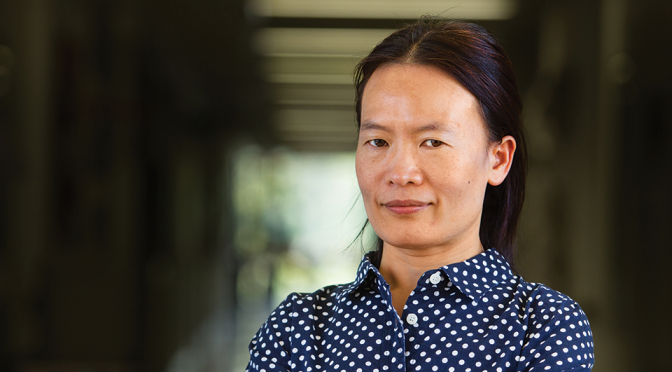In most research, there’s no such thing as “minor details” or “the small stuff.” This is especially true for Xiaolan Yao, Ph.D. Her research team makes and uses three-dimensional models of proteins, and for those models to be accurate, every atom counts.
She and her team — currently two graduate students and two undergraduates — work with relatively large protein molecules, or macromolecules. These molecules are still far too small to be “seen” by conventional methods, but their three-dimensional structure — how the atoms in a macromolecule are arranged — can be determined by techniques such as X-ray crystallography or magnetic resonance spectroscopy, tools that Yao and her team use routinely to “visualize” the proteins they study.
Yao, an associate professor in the Division of Molecular Biology and Biochemistry in the School of Biological Sciences, is investigating the structure and function of lipid transfer carriers, proteins that are essential to many processes inside every human cell. Despite the tiny scale of her research, its implications are huge, for everything from cancer and diabetes to how people age.
“These proteins move greasy lipid molecules from one part of the cell to another,” says Yao, who also teaches undergraduate and graduate biochemistry classes. “I tell my students they can think of a cell as a society, and these proteins as the workers, or as the different kinds of machines needed to do different jobs.”
Yao, whose research is funded by a grant from the National Institutes of Health, says many lipid transfer proteins also appear to have regulatory functions, turning certain cellular processes on and off.
Yao’s research focuses on just one protein, known as CERT, short for ceramide transfer protein. Ceramide is a group of waxy molecules that are important components of the cellular membranes and regulators of a variety of cellular processes. Discoveries regarding how CERT works would most likely apply to other lipid transfer proteins, too. And gaining a better understanding of how CERT works could help combat several diseases.
“For example, there is evidence that CERT is hijacked by pathogens such as Hepatitis C virus for its replication inside the host cell,” she says. “That’s also true with chlamydia, a sexually transmitted, intracellular bacterium.”
It also appears that certain cancer cells make a lot more CERT protein than normal cells to evade chemotherapeutic drugs.
“If we can find an effective way to inhibit CERT, we could develop more effective cancer therapies,” Yao says.
She also says such applications would be up to other research teams “down the road.” But to a biochemist like her, she is completely satisfied with the basic research of gaining a better understanding and appreciation of the beauty and elegance of the molecules themselves. Her work studying the protein’s atomic structure and how that allows it to communicate with other molecules has its own challenges and rewards — and will enable and underpin later-applied research.
Yao, who grew up in China’s Henan Province, earned her bachelor’s and master’s degrees in chemistry at Zhengzhou University. Her father, Qiming Yao, was a chemistry professor there and always pushed her to do her best.
After earning her bachelor’s and master’s degrees in China, where more industrial technician positions rather than research jobs were available, she applied to U.S. graduate schools, and was accepted to a doctoral program at Iowa State University. There she was inspired by the work of Mei Hong, Ph.D., an assistant professor who became her Ph.D. advisor.
Hong got Yao interested in using nuclear magnetic resonance spectroscopy to determine how atoms were arranged in proteins to form elaborate three-dimensional structures. Yao said she also benefited tremendously from her postdoctoral training in the lab of Mike Rosen, Ph.D., at the University of Texas Southwestern Medical Center in Dallas.
She came to UMKC in September 2010, in part, she says, “because the atmosphere seemed so collegial and helpful, and that has been true. I have many wonderful colleagues.” Yao credits UMKC faculty members Samuel Bouyain, Marilyn Yoder and Brian Geisbrecht, who is now at Kansas State University, with helping her advance her use of X-ray crystallography.
It’s also clear, watching her display and explain her 3-D molecular models, that she finds her quest for greater fundamental knowledge and understanding of protein structures and cell functions exciting. And she enjoys sharing her enthusiasm with her students and colleagues.
“Why do any of us do what we do?” she says. “It should be because it is fun!”



